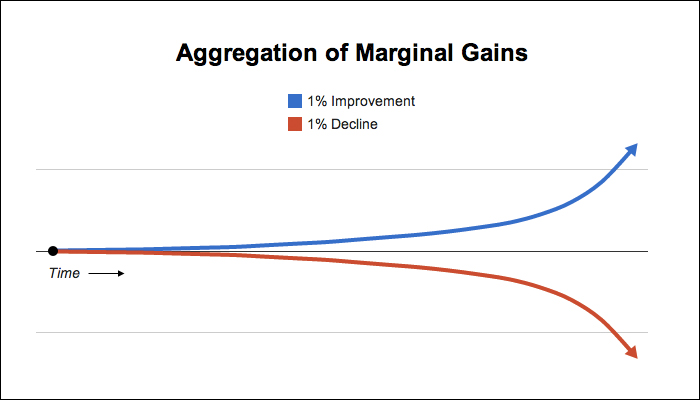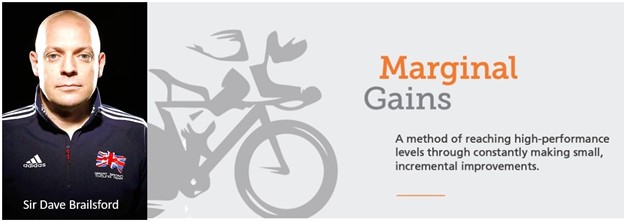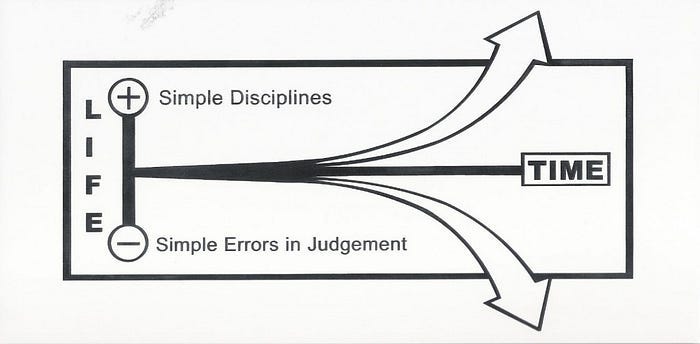
Marginal Gains
In a world obsessed with overnight success, marginal gains offer a refreshing perspective on achieving excellence.
Rooted in the philosophy of making small, incremental improvements, marginal gains focus on the cumulative impact of these tiny changes.
In the SEO world, everyone is obsessed with the latest hacks and knowledge bombs to fast-track their rankings. However, many SEOs need to Master the Art of Continuous Improvement and aim for a 1% increase every day for a year.
This approach has revolutionised various fields, from elite sports to business, demonstrating that consistent, focused effort can lead to extraordinary outcomes.
By meticulously honing every detail, individuals and organisations can unlock significant progress, proving that success often lies in the margins.
Let’s look into the principles, applications, and unique facets of marginal gains, revealing how they can drive sustained success.
Contents
- The Aggregation of Marginal Gains
- What is Marginal Gains Theory?
- What is the core principle of Continuous Improvement in the context of Marginal Gains?
- How do small, incremental changes contribute to significant overall results?
- Can you provide examples of cases where continuous improvement has led to substantial success?
- How does the Compound Effect work in the context of Marginal Gains?
- Why is focusing on details crucial for achieving success through Marginal Gains?
- How can paying attention to minor aspects lead to significant improvements in performance?
- What strategies can ensure that every detail is optimised in a Marginal Gains approach?
- Why is a systematic approach important for effectively implementing Marginal Gains?
- What are the critical steps in developing a structured method for identifying and applying improvements?
- How can a systematic approach enhance the consistency and effectiveness of Marginal Gains over time?
- Why is regular measurement and analysis essential for the success of Marginal Gains?
- What metrics should be used to measure the progress of Marginal Gains initiatives effectively?
- How can the analysis of results inform and refine future improvements in a Marginal Gains strategy?
- How can the principles of Marginal Gains be effectively adapted and applied across different fields such as business, education, and personal development?
- What strategies can organisations use to successfully embed the Marginal Gains mindset into their culture to ensure lasting impact?
- Why is it important to prioritise a long-term vision when implementing Marginal Gains, and how can this approach lead to sustained success?
- How can Marginal Gains be leveraged to drive innovation and creativity rather than focusing solely on improving efficiency?
- What role does psychological resilience play in the Marginal Gains approach, and how can it be developed to maintain consistent progress?
- How can Marginal Gains be tailored to individual strengths and weaknesses to maximise personal and professional development?
- How can Marginal Gains be applied to promote eco-friendly and sustainable practices within an organisation or personal lifestyle?
- What role can advanced technologies like AI and machine learning play in identifying and implementing Marginal Gains more effectively?
- How can organisations ensure that their pursuit of Marginal Gains aligns with ethical standards and social responsibility?
- How can collaborating with external partners or teams enhance the effectiveness and impact of Marginal Gains initiatives?
- How can the concept of Marginal Gains be applied to improve investment strategies and portfolio performance?
- In what ways can small adjustments to interest rates or savings habits lead to significant financial growth over time through the principle of Marginal Gains?
- SEO Marginal Gains – The Little Things Add Up
- Summary
The Aggregation of Marginal Gains
It’s easy to overestimate the importance of a single defining moment and underestimate the impact of small, daily improvements.
We often convince ourselves that massive success demands massive action – losing weight, building a business, writing a book, winning a championship, or achieving any goal. This mindset creates pressure to achieve earth-shattering results that everyone will notice.
However, improving by just 1 per cent each day might not seem significant – it’s often barely noticeable – but it can be mighty in the long run.
The cumulative effect of these small gains is astonishing: if you improve by 1% improvement each day for a year, you’ll end up 37 times better.
Conversely, if you decline by 1 percent improvement each day, you’ll nearly drop to zero. What begins as a minor win or setback accumulates into something far greater.
A great example of this is football legend Lionel Messi, who famously said, “It took me 17 years and 114 days to become an overnight success.”

It wasn’t just one game that defined him – it was the hard work of many years of training and countless small improvements.
Initially, there’s little difference between making a 1 per cent better or worse choice. It doesn’t seem to matter much today. But as time passes, these small improvements or declines compound, creating a significant gap between those who make slightly better daily decisions and those who don’t. This is why small choices might not seem impactful at the moment, but they add up significantly over the long term.
This concept also underscores the importance of setting schedules for critical tasks, planning for setbacks, and following the “never miss twice” rule. A slip-up or mistake now and then isn’t a big deal. The real issue arises when you fail to get back on track. By committing to never miss twice, you can prevent minor errors from snowballing into major problems.
What is Marginal Gains Theory?
The Marginal Gains Theory suggests that making small improvements across multiple areas leads to significant overall progress.
Focusing on marginal improvement leverages the power of tiny gains to create substantial, long-term success.
The theory of marginal gains means focusing on improving every process and procedure, even slightly, rather than seeking one big advantage, allowing marginal gains to stack up.
What is the core principle of Continuous Improvement in the context of Marginal Gains?
The core principle of Continuous Improvement in the context of Marginal Gains is the idea that success is achieved through a series of small, incremental changes rather than drastic overhauls.
This approach focuses on consistently refining processes, behaviours, or strategies to enhance overall performance.
By making tiny, manageable improvements regularly, these changes compound over time, leading to significant progress.
How do small, incremental changes contribute to significant overall results?
Small, incremental changes contribute to significant overall results through the compound effect.
Each minor improvement may seem negligible on its own, but when combined with others and applied consistently, these changes build upon each other.
Over time, this accumulation of small gains can lead to a substantial transformation, as the collective impact far outweighs the sum of individual efforts.
This approach also reduces the risk of burnout and resistance, as changes are more accessible to implement and sustain.
Can you provide examples of cases where continuous improvement has led to substantial success?
One notable example of Continuous Improvement leading to substantial success is the transformation of the British Cycling Team under coach Sir David Brailsford.
The team achieved unprecedented success by focusing on marginal gains in various areas, such as bike ergonomics, athlete nutrition, and even sleep quality, including multiple Olympic gold medals.

The Sir Dave Brailsford marginal gains are a great real-life example. His team continued to find 1 percent improvements in overlooked and unexpected areas. As continuous 1% improvements and hundreds of other minor improvements accumulated, the results came faster than anyone imagined.
Another example is Toyota’s implementation of the Kaizen philosophy, which emphasises continuous improvement in manufacturing processes.
This approach has made Toyota one of the most efficient and profitable automotive companies globally.
How does the Compound Effect work in the context of Marginal Gains?
The Compound Effect in the context of Marginal Gains refers to the process by which small, incremental improvements accumulate over time to produce significant overall results.
Each minor enhancement builds on the previous ones, creating a multiplying effect where the impact of these changes grows exponentially.
This approach recognises that consistent, small efforts can lead to substantial outcomes, as the benefits of each improvement are amplified through continuous application.
By appreciating the power of the Compound Effect, individuals and organisations can remain motivated and patient, knowing that even small changes, when consistently applied, will eventually result in significant progress.
Why is focusing on details crucial for achieving success through Marginal Gains?
Focusing on details is crucial in a Marginal Gains approach because it allows for identifying and optimising every possible aspect that can contribute to overall success.
Even the smallest elements, often overlooked, can significantly impact when improved.
By addressing these minute details, you ensure that no opportunity for enhancement is missed, ultimately leading to a compounded effect that drives substantial progress.
How can paying attention to minor aspects lead to significant improvements in performance?
Paying attention to minor aspects can lead to significant improvements in performance because these small adjustments collectively create a ripple effect.
When each minor detail is optimised, it enhances efficiency, reduces errors, and improves the overall process or performance.

These incremental gains, when combined, can lead to a noticeable and often dramatic improvement in the final outcome, far beyond what could be achieved by focusing only on larger changes.
What strategies can ensure that every detail is optimised in a Marginal Gains approach?
To ensure that every detail is optimised in a Marginal Gains approach, start by thoroughly analysing all processes and identifying areas where even the smallest improvements can be made.
Implement a systematic approach to continuously monitor and evaluate these details, using data-driven methods to measure progress.
Encourage a culture of meticulousness where every team member is aware of the importance of minor optimisations.
Additionally, utilise feedback loops and regular reviews to fine-tune and adapt strategies, ensuring that every aspect is constantly refined and improved.
Why is a systematic approach important for effectively implementing Marginal Gains?
A systematic approach is crucial for effectively implementing Marginal Gains because it provides a structured framework that ensures all potential areas for improvement are thoroughly examined and optimised.
This approach prevents haphazard or random attempts at improvement by establishing clear processes for identifying, prioritising, and applying small changes.
By following a systematic method, organisations and individuals can achieve consistent, measurable progress, ensuring that every opportunity for gain is capitalised upon.
What are the critical steps in developing a structured method for identifying and applying improvements?
Developing a structured method for Marginal Gains involves several key steps:
- Assessment: Conduct a comprehensive analysis of current processes to identify areas for improvement.
- Prioritisation: Rank these areas based on their potential impact and ease of implementation.
- Planning: Develop a detailed plan for applying the identified improvements, including timelines, resources needed, and success metrics.
- Implementation: Systematically apply the planned improvements, ensuring each step is executed precisely.
- Monitoring and Review: Continuously track progress, measure outcomes, and adjust the strategy as necessary to maximise effectiveness.
How can a systematic approach enhance the consistency and effectiveness of Marginal Gains over time?
A systematic approach enhances the consistency and effectiveness of Marginal Gains by providing a repeatable process that can be applied continuously.
This ensures that improvements are not one-off efforts but part of an ongoing cycle of refinement and optimisation.
By regularly reviewing and adjusting the approach based on data and outcomes, the systematic method ensures that gains are sustained and amplified over time, leading to long-term success and improvement.
Why is regular measurement and analysis essential for the success of Marginal Gains?
Regular measurement and analysis are essential for the success of Marginal Gains because they provide the data needed to assess the effectiveness of each small improvement.
Without consistent measurement, it’s impossible to determine whether the implemented changes have the desired impact.
Analysis allows for informed decision-making, ensuring efforts are directed towards the most effective areas.
This continuous feedback loop is vital for refining strategies and achieving long-term success through Marginal Gains.
What metrics should be used to measure the progress of Marginal Gains initiatives effectively?
The metrics used to measure the progress of Marginal Gains initiatives should be specific, relevant, and aligned with the overall goals. These could include:
- Performance metrics: Such as productivity levels, error rates, or output quality.
- Efficiency metrics: Like time saved, cost reductions, or resource utilisation improvements.
- Engagement metrics: In cases where team or individual participation is key, measuring engagement or adherence to new processes can be important.
- Outcome metrics: Such as customer satisfaction, sales growth, or market share increases, to link improvements directly to business results.
These metrics should be tracked regularly to ensure that each incremental change contributes to the overall objectives.
How can the analysis of results inform and refine future improvements in a Marginal Gains strategy?
The analysis of results allows for identifying what is working well and what is not, enabling informed adjustments to the Marginal Gains strategy.
By examining the data, you can pinpoint the most effective changes and focus on scaling these, while also identifying areas that need further refinement.
This ongoing analysis ensures that the strategy evolves based on real-world performance, leading to more precise and impactful improvements over time.
It also helps in avoiding wasted effort on changes that do not yield significant benefits.
How can the principles of Marginal Gains be effectively adapted and applied across different fields such as business, education, and personal development?
The principles of Marginal Gains can be adapted to various fields by identifying key areas where small, incremental improvements can lead to significant outcomes.
This might involve refining processes, enhancing customer experience, or optimising team performance in business.
Marginal Gains could be applied in education by improving teaching methods, student engagement, or curriculum design.
For personal development, individuals can focus on habit formation, skill enhancement, or time management.
The key is to apply the same systematic approach of breaking down larger goals into smaller, manageable steps and consistently working towards improvement.
What strategies can organisations use to successfully embed the Marginal Gains mindset into their culture to ensure lasting impact?
To embed the Marginal Gains mindset into organisational culture, leaders must promote and model this approach.
They can foster a culture of continuous improvement by encouraging employees to focus on small, daily enhancements and recognising those efforts publicly.
Providing training and resources on Marginal Gains can also help employees understand its value. Additionally, integrating Marginal Gains into performance reviews and setting incremental goals as part of project planning can reinforce this mindset.
By making Marginal Gains a core part of the organisation’s operation, they become ingrained in the culture, leading to lasting impact.
Why is it important to prioritise a long-term vision when implementing Marginal Gains, and how can this approach lead to sustained success?
Prioritising a long-term vision when implementing Marginal Gains is crucial because the full impact of incremental improvements often takes time to materialise.
A long-term perspective helps maintain focus on sustained progress rather than seeking immediate, short-lived results.
This approach encourages patience, persistence, and consistency, which are essential for the compound effect of Marginal Gains to take hold.
Over time, these small, continuous improvements can lead to substantial, lasting success that wouldn’t be achievable through quick fixes or short-term strategies.
How can Marginal Gains be leveraged to drive innovation and creativity rather than focusing solely on improving efficiency?
Marginal Gains can drive innovation and creativity by encouraging a mindset that constantly seeks new ways to improve, no matter how small.
This mindset naturally leads to experimentation and exploration of unconventional ideas.
Organisations can identify innovative approaches that provide a competitive edge by applying Marginal Gains to areas like product development, marketing strategies, or customer interactions.
The emphasis on continuous improvement means that even small, creative ideas are tested, refined, and implemented, fostering an environment where innovation becomes a routine part of the process rather than an occasional breakthrough.
What role does psychological resilience play in the Marginal Gains approach, and how can it be developed to maintain consistent progress?
Psychological resilience is vital in the Marginal Gains approach because small, continuous improvements can be slow and require sustained effort over time.
Resilience helps individuals and teams stay committed to the process, even when immediate results are absent.
To develop this resilience, setting realistic expectations, celebrating small victories, and focusing on long-term goals is important.
Building a supportive environment where challenges are viewed as opportunities for growth also fosters resilience.
By maintaining a resilient mindset, individuals and organisations can persist in their efforts, ensuring that the cumulative benefits of Marginal Gains are realised over time.
How can Marginal Gains be tailored to individual strengths and weaknesses to maximise personal and professional development?
Marginal Gains can be tailored to individual strengths and weaknesses by thoroughly assessing an individual’s capabilities, areas for improvement, and personal goals.
Customising the approach involves enhancing existing strengths while making incremental adjustments to address weaknesses.
This personalisation ensures that the improvements are relevant and impactful for the individual, leading to more significant personal and professional development progress.
The strategy becomes more effective and sustainable by aligning the gains with individual needs.
How can Marginal Gains be applied to promote eco-friendly and sustainable practices within an organisation or personal lifestyle?
Marginal Gains can be applied to sustainability by identifying small, actionable changes that reduce environmental impact.
This might involve optimising energy use, reducing waste, and sourcing eco-friendly materials for organisations.
It could mean reducing plastic use, conserving water, or choosing sustainable transportation options.
Focusing on incremental, eco-friendly improvements, these small steps can collectively lead to a significant reduction in environmental footprint, promoting long-term sustainability in both organizational practices and individual lifestyles.
What role can advanced technologies like AI and machine learning play in identifying and implementing Marginal Gains more effectively?
Advanced technologies like AI and machine learning can play a pivotal role in identifying and implementing Marginal Gains by analysing vast amounts of data to pinpoint areas for improvement that humans might overlook.
These technologies can automate monitoring performance, detect patterns, and suggest real-time optimisations.
For example, AI can enhance customer service through personalised recommendations or optimise supply chain efficiency by predicting demand.
By leveraging technology, organisations can achieve more precise, data-driven improvements, accelerating the pace and impact of Marginal Gains.
Organisations can ensure that their pursuit of Marginal Gains aligns with ethical standards by embedding ethical considerations into every decision-making process.
This involves conducting ethical reviews of proposed improvements, assessing their potential social and environmental impacts, and ensuring transparency in their implementation.
Organisations should also engage stakeholders, including employees and customers, in discussions about the ethical implications of their strategies.
By prioritising ethics, organisations can achieve Marginal Gains that improve performance, contribute positively to society, and uphold their corporate responsibility.
How can collaborating with external partners or teams enhance the effectiveness and impact of Marginal Gains initiatives?
Collaborating with external partners or teams can enhance the effectiveness of Marginal Gains initiatives by bringing in new perspectives, expertise, and resources that may not be available internally.
Partnerships can lead to shared knowledge and best practices, enabling more innovative and comprehensive improvements.
For example, collaborating with a tech partner could provide access to cutting-edge tools for optimisation, while working with industry peers could reveal new strategies for incremental gains.
By leveraging the strengths of multiple parties, organisations can amplify the impact of their Marginal Gains efforts, achieving results greater than the sum of their parts.
How can the concept of Marginal Gains be applied to improve investment strategies and portfolio performance?
The concept of Marginal Gains can be applied to investment strategies by focusing on making small, continuous improvements in various aspects of portfolio management.
For example, investors can regularly rebalance their portfolios to maintain the desired risk level, gradually increase exposure to growth assets, or systematically reduce costs by opting for low-fee investment funds.
Additionally, they can enhance returns by consistently reinvesting dividends, making slight adjustments based on market conditions, or improving the timing of investment entries and exits.
Over time, these minor tweaks can compound, significantly boosting overall portfolio performance and aligning it more closely with long-term financial goals.
In what ways can small adjustments to interest rates or savings habits lead to significant financial growth over time through the principle of Marginal Gains?
Small adjustments to interest rates or savings habits can lead to significant financial growth over time by harnessing the power of compounding.
For instance, slightly increasing the interest rate on savings by switching to a higher-yield account or consistently adding a small additional amount to monthly savings can have a substantial impact on the total savings accumulated over the years.
Even minor changes, such as rounding up purchases to save the difference or automating incremental increases in savings contributions, can contribute to a larger financial cushion.
When compounded over time, these small, disciplined actions can lead to considerable financial growth, illustrating the principle of Marginal Gains in personal finance.
SEO Marginal Gains – The Little Things Add Up
The beauty of SEO Marginal Gains lies in the continuous improvement mindset.
Frankly, I’m tired of people attending masterminds, expecting some magic, push-button solution or knowledge bomb.
SEO isn’t about quick fixes; it’s about accumulating small wins over time and “doing all things correctly,” step by step, to see significant results.
What SEO Marginal Gains Can Boost Your Website’s Ranking?
SEO Marginal Gains that can boost your website’s ranking include:
- Optimising page load speed
- Refining meta tags and descriptions
- Implement schema markup
- Improving internal linking structures
- Regularly updating content for relevance
- Enhancing mobile responsiveness
- Building high-quality backlinks
- Monitoring and adjusting keyword strategies
- Improving user experience
- Ensuring technical SEO elements are in place
All these minor SEO wins contribute to gradual, significant improvements in search engine rankings.
These small, cumulative actions lead to better visibility and higher rankings over time.
Summary
The concept of Marginal Gains highlights the profound impact of small, consistent improvements over time.
Rather than relying on single, defining moments, success is often the result of many tiny, daily changes that compound to create significant results.
Drawing on examples from sports, personal finance, and business, the article emphasises the importance of focusing on these small gains, using a systematic approach, and maintaining psychological resilience.
The idea that minor adjustments can lead to extraordinary outcomes is supported by the experiences of figures like Lionel Messi, who achieved greatness not through one game but through years of incremental progress.
Individuals and organisations can achieve sustained success in any field by understanding and applying Marginal Gains.
Success comes from practising a few simple disciplines every day, while failure is the result of a few daily errors in judgment
You may not find yourself racing in the Tour de France anytime soon, but the principle of accumulating marginal gains is still highly relevant.
People often view success (and life) as a singular event.
We talk about losing 50 pounds, building a successful business, or winning the Tour de France as if they happen in a moment.
However, the reality is that most significant achievements are not one-time events but the cumulative result of countless instances where we chose to be 1 percent better or worse. It’s the aggregation of these small gains that truly makes a difference.
There’s immense power in small, steady improvements. This is why consistent effort produces exceptional results. It’s why the process matters more than the goal. Mastering your habits is more crucial than merely achieving a specific outcome.

About FatRank
FatRank is a UK-based lead generation and ORM agency that delivers high-quality leads, enhances brand reputation online, and shares expert insights on SEO and AI innovation.
Need exclusive leads?
We deliver a consistent flow of high-quality exclusive leads. No fluff. No guesswork.
Get free leads →★★★★★ Excellent
